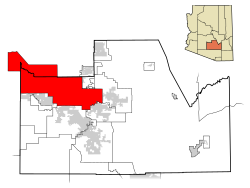Gila River Indian Community
| |
|---|---|
 Location of Gila River Indian Community in northwestern Pinal County, Arizona. The Phoenix metropolitan area is located north of the reservation. | |
| Country | United States |
| State | Arizona |
| Area | |
| • Total | 1,511.90 km2 (583.749 sq mi) |
| Population (2020) | |
| • Total | 14,260 |
| Website | Gila River Indian Community |
The Gila River Indian Community (GRIC) (O'odham language: Keli Akimel Oʼotham, meaning "Gila River People", Maricopa language: Pee-Posh) is an Indian reservation in the U.S. state of Arizona, lying adjacent to the south side of the cities of Chandler and Phoenix, within the Phoenix Metropolitan Area in Pinal and Maricopa counties. The Gila River Indian Community was established in 1859, and the Gila River Indian Community was formally established by Congress in 1939. The community is home for members of both the Akimel O’odham (Pima) and the Pee-Posh (Maricopa) tribes.
The reservation has a land area of 583.749 square miles (1,511.90 km2) and a 2020 Census population of 14,260.[1] It is made up of seven districts[2] along the Gila River and its largest communities are Sacaton, Komatke, Santan, and Blackwater. Tribal administrative offices and departments are located in Sacaton. The Community operates its own telecom company, electric utility, industrial park and healthcare clinic, and publishes a monthly newspaper. It has one of the highest rates of Type 2 diabetes in the world, around 50% of the population.[3] The community voluntarily contributes to Type 2 diabetes research, having participated in many studies of the disease.[4]

- ^ "Gila River Indian Community Primary Care Area (PCA) – 2021 Statistical Profile" (PDF).
- ^ "Discover the Gila River Indian Community". www.gilariver.org.
- ^ A political economy of diabetes, pregnancy, and identity in the Gila River Indian Community, Carolyn Smith-Morris, 2001. Dissertation (Advisor Ana T. Ortiz) University of Arizona
- ^ Pearson, Ewan R. (December 2015). "Dissecting the Etiology of Type 2 Diabetes in the Pima Indian Population". Diabetes. 64 (12): 3993–3995. doi:10.2337/dbi15-0016. PMID 26604175. Retrieved June 12, 2024.

